


The Lewis and Clark expedition was the first to report dinosaurs linked with locations that would one day be protected by the National Park Service. William Clark discovered a massive fossil bone, most likely from a dinosaur, at Pompey's Pillar in Montana on July 25, 1806. This was along the route that is now known as the Lewis and Clark National Historic Trail. The study of dinosaurs began in earnest in North America in the 1850s, with one of the earliest specimens including more than a bone or two recovered from Springfield Armory in 1855. Megadactylus polyzelus (renamed Anchisaurus) was characterized as a tiny herbivore. Earl Douglass' finding was probably the most significant event for the study of dinosaurs in NPS regions.
THE LOSSING WORLD ENDANGERED SPECIES :
 “POLAR BEAR”
“POLAR BEAR”
ITS SURVIVAL TO THE MODERN ENVIRONMENTAL CONDITION:-
Polar bears are in grave danger of extinction as a result of climate change. The polar bear was the first vertebrate species to be classified as threatened under the United States Endangered Species Act in 2008, because to expected climate change. The Secretary of the Interior categorized the polar bear as threatened but limited Endangered Species Act protections, putting the polar bear's future in doubt.
The polar bear's main threat is the loss of its sea ice habitat due to climate change. The polar bear, as implied by its scientific name (Ursus maritimus), is a marine mammal that spends significantly more time at sea than on land.
1. Polar bears are categorized as marine mammals since they spend so much time in the ocean. Ursus maritimus, the scientific name for the polar bear, means "sea bear."
2. Polar bears originated from brown bears in order to thrive in harsh northern climates.
3. Polar bears are the world's largest terrestrial predators, with giant males standing more than 11 feet (3.3 meters) on their hind legs and weighing more than 1,700 pounds (770 kilograms).
4. Polar bears, unlike black and brown bears, do not hibernate during the winter months since that is when sea ice forms, which the polar bears require to hunt seals.
5. Polar bears communicate with each other using grunts, growls, roars, or squeals when necessary or when playing.


